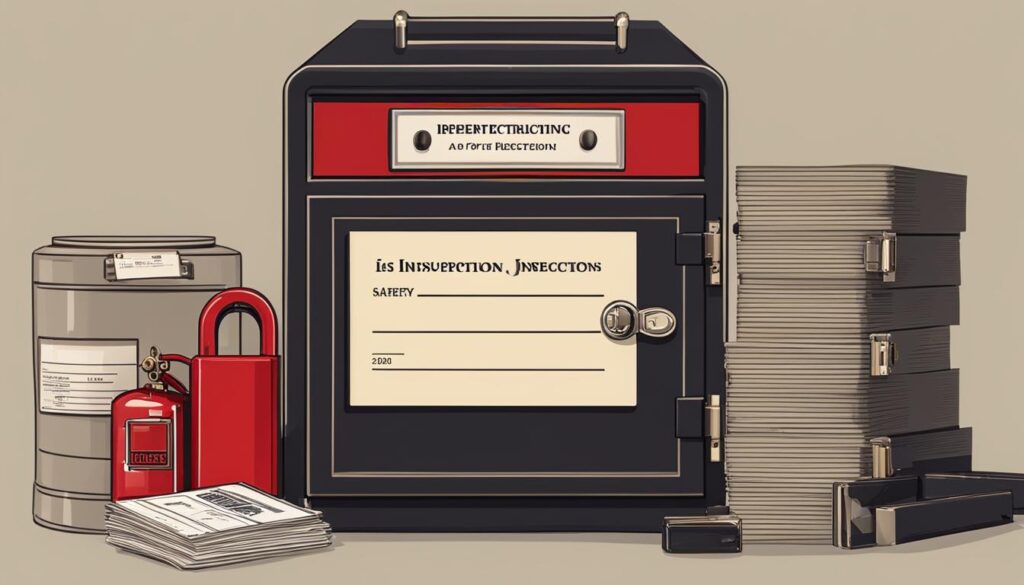Insurance is crucial for protecting your valuable assets such as your home, personal belongings, and business. However, many homeowners in the United States do not have adequate insurance coverage. It is essential to document your property, understand your policy options, and ensure appropriate coverage for relevant hazards. Additionally, maintaining a detailed inventory of your belongings, storing vital records in a safe place, and knowing what your policy covers are important steps in insurance monitoring.
Key Takeaways:
- Insurance coverage is essential for protecting your assets.
- Document your property and understand your policy options.
- Maintain a detailed inventory of your belongings.
- Store vital records in a safe place.
- Know what your policy covers and stay informed about insurance regulations.
Document and Insure Your Property
Property insurance is a crucial aspect of protecting your financial resources in the event of a disaster. Unfortunately, more than half of homeowners in the United States do not have adequate coverage. To ensure you are prepared for any unforeseen circumstances, it is essential to document your property, understand your coverage options, and regularly review and update your policy.
Documenting your property is the first step in securing appropriate insurance coverage. Create a detailed inventory of your belongings, including descriptions, year, make, and model numbers. Take photos or videos of your valuable items and keep them alongside your inventory. This documentation will prove the value of your belongings and expedite the claims process in the event of a loss.
Understanding your coverage options is equally important. Regularly review your policy to ensure it provides adequate protection against relevant hazards. Consider factors such as property value, potential risks in your area, and any new purchases or renovations that may require additional coverage. By staying informed and making necessary updates, you can ensure your insurance policy reflects the current value of your property.
Ultimately, property insurance is a vital tool in securing your financial well-being. By documenting your property, understanding your coverage options, and regularly reviewing your policy, you can protect your financial resources and gain peace of mind knowing that you are adequately insured against potential disasters.
In a Nutshell:
- Create a detailed inventory of your belongings and keep it alongside photos or videos.
- Regularly review your policy to ensure it provides adequate coverage against relevant hazards.
- Make necessary updates to your policy based on changes in property value, new purchases, or renovations.
Documenting Your Property and Safeguarding Records
Creating a detailed inventory of your property’s contents is vital in preparing for potential disasters. Not only does it help prove the value of your belongings, but it also expedites the claim process and allows for potential tax deductions. When documenting your property, it’s important to take thorough and comprehensive steps.
Start by taking clear photos or videos of each room in your home or business. These visual records will serve as evidence of the items you own. Write down detailed descriptions of each item, including its year, make, and model numbers. This information will be valuable when filing insurance claims.
For high-value items such as art pieces, jewelry, or antiques, consider getting a professional appraisal to determine their worth. This appraisal will provide an accurate valuation and ensure that you have appropriate coverage for these valuable possessions.
Once you have documented your property, it’s crucial to safeguard these records. Store them in a safe and secure location, such as a fireproof safe or a cloud-based storage service. Ensuring easy accessibility to your inventory after a disaster will help streamline the claims process and mitigate the stress of the situation.

Key Takeaways:
- Create a detailed inventory of your property’s contents, including photos, descriptions, and appraisal for high-value items.
- Store your records in a secure location, such as a fireproof safe or cloud-based storage.
- Easy accessibility to your inventory will expedite the claims process in the event of a disaster.
Understanding What a Policy Covers
When it comes to insurance, understanding what a policy covers is essential for homeowners, renters, and business owners alike. Different types of insurance, such as homeowner’s insurance, renter’s insurance, and business insurance, provide coverage for various aspects that protect your assets and provide financial security. Let’s take a closer look at what each of these policies typically covers:
Homeowner’s Insurance
Homeowner’s insurance typically covers the dwelling itself, including the structure of your home, as well as other structures on your property, such as sheds or garages. It also provides coverage for personal property, which includes your belongings inside the home. In the event of a covered loss, homeowner’s insurance can help replace or repair your belongings. Additionally, it offers protection against liability claims if someone is injured on your property and covers medical payments for their injuries.
Renter’s Insurance
Renter’s insurance is specifically designed for tenants who are renting a property. It provides coverage for personal property, similar to homeowner’s insurance, but without the dwelling coverage since the rented property is typically covered by the landlord’s insurance. Renter’s insurance also offers liability protection in case someone gets injured in your rented space and covers their medical payments. It’s important to note that the landlord’s insurance typically does not cover your personal belongings, which is why it’s essential to have renter’s insurance to protect your belongings from theft, fire, or other covered perils.
Business Insurance
Business insurance is crucial for protecting your business property, assets, and employees. Depending on the type of business you have, the coverage can include property insurance, liability insurance, business interruption insurance, and more. Property insurance protects your physical assets, such as buildings, equipment, and inventory. Liability insurance provides coverage if your business is held responsible for causing harm to someone or damaging their property. Business interruption insurance helps cover the loss of income and expenses if your business is temporarily unable to operate due to a covered event. It’s important to tailor your business insurance policy to suit the specific needs and risks of your business.
Consulting with an insurance professional can help you understand the details of each policy and ensure that you have the appropriate coverage for your needs. By having a comprehensive understanding of what your policy covers, you can protect your assets and have peace of mind knowing that you are adequately protected.
| Policy Type | Key Coverage Areas |
|---|---|
| Homeowner’s Insurance | Dwelling, other structures, personal property, loss of use, personal liability, medical protection |
| Renter’s Insurance | Personal property, loss of use, personal liability, medical payments, property damage to others |
| Business Insurance | Property, liability, business interruption, business vehicles, workers’ compensation, flood, cyber liability, terrorism |
How Fraud is Detected
Insurance fraud is a significant issue that insurance companies constantly strive to combat. To identify potential fraudulent activities, insurance companies have established special investigation units (SIUs) that work closely with law enforcement agencies. These SIUs employ various techniques, including data analytics and antifraud databases, to detect suspicious behavior.
Fraud investigators in SIUs are trained to identify red flags during the claims process and investigate any unusual activities. They analyze patterns, trends, and anomalies in the data to uncover potential fraud cases. By leveraging advanced data analytics techniques, they can detect inconsistencies and identify individuals who may be trying to manipulate the system.
“Insurance fraud is a serious crime that impacts not only insurance companies but also policyholders who end up paying higher premiums as a result. Our fraud investigators are constantly on the lookout for any indication of fraudulent activities and work diligently to protect our customers and maintain the integrity of our insurance policies.” – Insurance Company Representative
Additionally, fraud investigators collaborate with antifraud bureaus and industry associations to share information and resources. This collaboration facilitates the detection and prevention of insurance fraud on a broader scale, contributing to the overall efforts to combat fraudulent activities in the insurance industry.
| Techniques used to detect insurance fraud | Advantages |
|---|---|
| Data analytics | Allows for the identification of patterns, trends, and anomalies in data, enabling fraud investigators to detect potential fraud cases. |
| Antifraud databases | Provide access to a wealth of information, including previous fraud cases and known fraudsters, helping investigators uncover suspicious behavior. |
| Social media monitoring | Allows investigators to monitor individuals’ online activities, potentially revealing fraudulent activities or contradictory information. |
Real Examples of Insurance Fraud Cases
Insurance fraud cases encompass a wide range of unethical and illegal activities that involve filing fraudulent claims to obtain undeserved payouts. These cases not only result in financial losses for insurance companies but also contribute to higher premiums for policyholders. Insurance fraud is a serious offense that can lead to felony charges, criminal convictions, fines, and imprisonment.
One common example of insurance fraud is filing claims for pre-existing damage. Individuals may attempt to obtain coverage for damages that occurred before the insurance policy was in effect, deliberately misleading the insurance company. Another example involves providing false information about stolen items, exaggerating their value or claiming items that were not actually stolen.
Some individuals misrepresent the use and location of their vehicles to obtain insurance coverage at lower rates. They may falsely claim that their vehicle is used for personal use when it is actually used for business purposes or provide false information about the vehicle’s garaging location. Staging accidents is another prevalent form of insurance fraud, where individuals intentionally cause accidents or fabricate injuries to receive insurance payouts.
Insurance fraud cases can have severe consequences, including felony charges, fines, and imprisonment. It is essential for insurance companies to investigate suspicious claims thoroughly and work closely with law enforcement agencies to combat fraudulent activities.

Table: Examples of Insurance Fraud Cases
| Insurance Fraud Case | Description |
|---|---|
| Pre-Existing Damage | Filing claims for damages that occurred before the insurance policy was in effect. |
| False Stolen Items | Providing false information about stolen items or exaggerating their value. |
| Misrepresentation of Vehicle Use | Misrepresenting the use and location of a vehicle to obtain lower insurance rates. |
| Staged Accidents | Intentionally causing accidents or fabricating injuries to receive insurance payouts. |
Insurance fraud cases not only harm insurance companies but also contribute to higher premiums for policyholders. It is crucial for individuals to understand the severe consequences of fraudulent claims and refrain from engaging in such illegal activities. Insurance companies employ fraud investigators and utilize advanced data analytics techniques to detect and prevent insurance fraud. By working together, insurance companies and law enforcement agencies can protect the integrity of the insurance industry and ensure fair and affordable coverage for policyholders.
Proposed Rules for Short-term, Limited-duration Insurance
Short-term, limited-duration insurance (STLDI) is a type of coverage that is designed to provide temporary healthcare benefits for individuals in specific circumstances. The proposed rules aim to amend the definition of STLDI and establish requirements for fixed indemnity insurance to be considered an excepted benefit under the law. These changes will help promote equitable access to high-quality, comprehensive coverage, while also ensuring clear distinctions between STLDI and comprehensive coverage under the Affordable Care Act.
One of the key aspects of the proposed rules is the clarification of the tax treatment of certain benefit payments in fixed amounts under employer-provided accident and health plans. This is an important step in ensuring that individuals who have fixed indemnity insurance receive the appropriate tax treatment for the benefits they receive. Additionally, the rules seek comments on coverage for specified diseases, illness, and level-funded plan arrangements.
These proposed rules are an important development in the insurance industry, as they seek to provide clarity and guidance regarding short-term, limited-duration insurance. By establishing clear definitions and requirements, individuals will have a better understanding of their coverage options and can make informed decisions about their healthcare plans. This will ultimately lead to more equitable access to comprehensive coverage for all individuals.

Summary
- The proposed rules aim to amend the definition of short-term, limited-duration insurance (STLDI) and establish requirements for fixed indemnity insurance to be considered an excepted benefit.
- These changes seek to promote equitable access to high-quality, comprehensive coverage and distinguish STLDI and fixed indemnity excepted benefits coverage from comprehensive coverage under the Affordable Care Act.
- The proposed rules also clarify the tax treatment of certain benefit payments in fixed amounts under employer-provided accident and health plans.
- Comments are invited regarding coverage for specified diseases, illness, and level-funded plan arrangements.
Conclusion
In conclusion, insurance monitoring is of utmost importance in ensuring comprehensive coverage and protection for your valuable assets. By diligently documenting your property, understanding your policy, and staying informed about insurance regulations and proposed rules, you can safeguard yourself against potential risks and losses.
Comprehensive coverage is essential for providing comprehensive protection and complying with regulatory requirements. It is crucial to consult with an insurance professional to tailor your policy to your specific needs and ensure adequate coverage for relevant hazards.
By actively monitoring your insurance plans, you can have peace of mind knowing that you are adequately protected. Remember, insurance is a vital tool for safeguarding your home, personal belongings, and business, so take the necessary steps to protect yourself and your assets.
FAQ
What is insurance monitoring?
Insurance monitoring involves actively keeping track of your insurance plans to ensure you have appropriate coverage and are protected against potential risks.
Why is it important to document and insure my property?
Documenting your property and ensuring adequate insurance coverage is crucial in providing financial resources to repair, rebuild, or replace your belongings in the event of a disaster.
How can I document my property and safeguard records?
Creating a detailed inventory of your property’s contents, including photos or videos and written descriptions, and storing vital records in a safe and secure location can help document your belongings and expedite the claims process.
What types of insurance policies are available?
There are various types of insurance policies available, including homeowner’s insurance, renter’s insurance, and business insurance, each providing coverage for different aspects of your property and liabilities.
How is insurance fraud detected?
Insurance fraud is detected through the work of fraud investigators who use specialized data analytics techniques, collaborate with law enforcement agencies, and monitor suspicious behavior during the claims process.
What are some examples of insurance fraud cases?
Examples of insurance fraud cases include filing false claims, providing false information about stolen items, misrepresenting the use and location of a vehicle, and staging accidents to obtain insurance payouts.
What are the proposed rules for short-term, limited-duration insurance?
The proposed rules aim to amend the definition of short-term, limited-duration insurance and the requirements for fixed indemnity insurance to be considered an excepted benefit, as well as clarify the tax treatment of certain benefit payments.
What is the conclusion of insurance monitoring?
Insurance monitoring is crucial in protecting your assets and ensuring you have appropriate coverage. It involves actively documenting your property, understanding your policy, and staying informed about insurance regulations and proposed rules to have comprehensive coverage and comply with regulatory requirements.
How Can Using a Bill Tracker Help with Managing Insurance Payments?
A bill tracking system can be a valuable tool for managing insurance payments. With this system, you can easily keep track of due dates and payment amounts, ensuring you never miss a payment. It helps you stay organized, avoid late fees, and maintain a good payment history, which can positively impact your insurance coverage.
How Can Insurance Inspectors Help Track and Monitor Income for Coverage Plans?
Insurance inspectors play a crucial role in tracking and monitoring diverse income sources to ensure accurate coverage plans. Their precision in assessing income helps determine appropriate coverage levels, preventing under or over-insurance. By thoroughly examining financial records, inspectors can guarantee that policies accurately reflect their clients’ true financial standings.
Source Links
- https://www.ready.gov/sites/default/files/2020-03/ready_document-and-insure-your-property.pdf
- https://www.ncdoi.gov/fraud-control/insurance-fraud-felony
- https://www.federalregister.gov/documents/2023/07/12/2023-14238/short-term-limited-duration-insurance-independent-noncoordinated-excepted-benefits-coverage